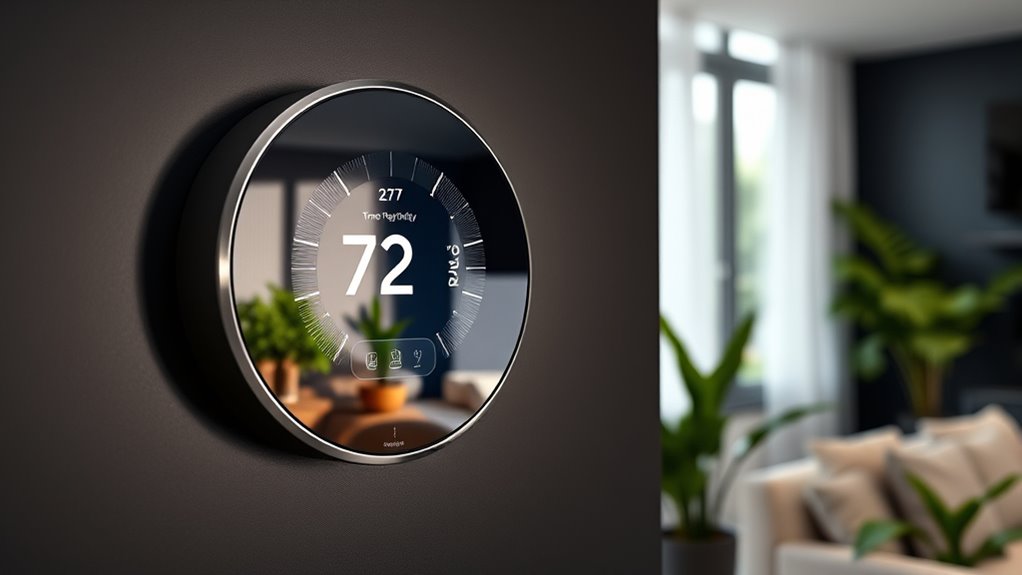If you’re exploring the best smart thermostats with learning abilities in 2025, I’ve got you covered. From the popular Google Nest (3rd Gen) to Ecobee’s enhanced models, these devices adapt to your schedule, optimize energy savings, and integrate with voice assistants. They’re user-friendly, compatible with various HVAC systems, and help you stay comfortable while saving money. Keep going to discover each option’s features and find the perfect one for your home.
Key Takeaways
- The list features top-rated smart thermostats with advanced learning algorithms for energy efficiency in 2025.
- It includes models compatible with various HVAC systems, supporting DIY installation or professional setup.
- Devices offer user-friendly interfaces, remote control, voice assistant integration, and adaptive scheduling features.
- The review highlights key differences in design, display, smart features, and compatibility among the best options.
- Energy savings, system monitoring, and multi-room management are prominent benefits of these thermostats.
Sensi Touch 2 Smart Thermostat with Touchscreen Display
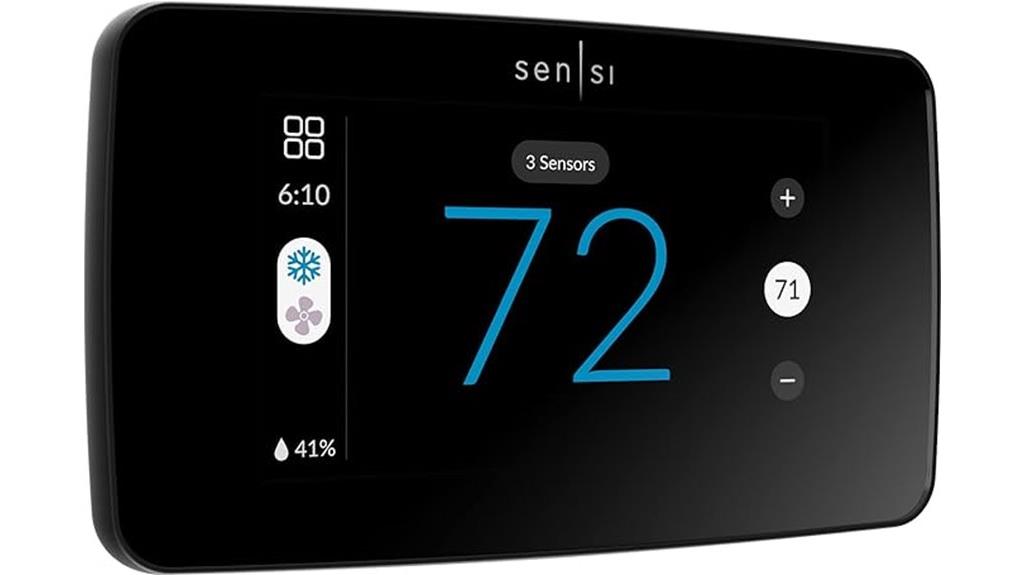
If you’re looking for a user-friendly smart thermostat that’s easy to install and offers precise control, the Sensi Touch 2 is an excellent choice. It features a vibrant touchscreen display and programmable settings that make managing your home’s temperature simple. With Wi-Fi connectivity, you can control it remotely and access detailed usage reports to optimize efficiency. Compatible with most HVAC systems and Sensi Room Sensors (sold separately), it helps balance temperature across rooms. Designed for DIY installation, it comes with clear instructions and a guided app setup. Plus, it’s Energy Star certified, helping you save around 23% on energy bills.
Best For: homeowners seeking an easy-to-install, feature-rich smart thermostat to enhance energy efficiency and control their home climate remotely.
Pros:
- User-friendly touchscreen display and intuitive app-guided installation
- Energy savings of approximately 23% with programmable scheduling and remote access
- Compatible with most HVAC systems and supports Sensi Room Sensors for multi-room temperature control
Cons:
- Requires a C-wire for installation, which may not be present in all homes
- Sensi Room Sensors are sold separately, adding to the overall cost
- Limited to Wi-Fi connectivity; no cellular or LTE options available
Honeywell Non-Programmable Thermostat, Single-Stage
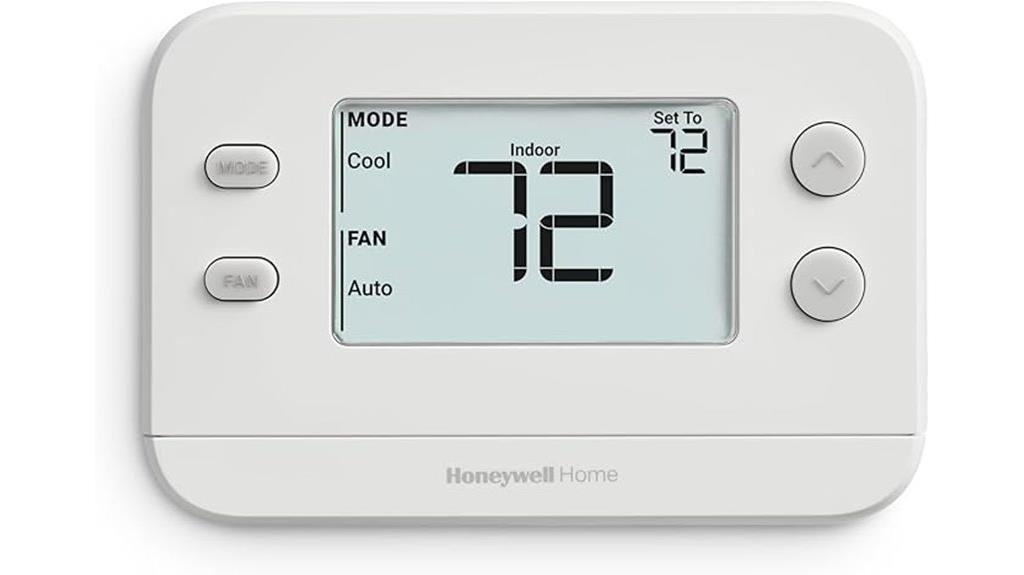
The Honeywell Non-Programmable Thermostat, Single-Stage is ideal for those seeking a simple, reliable control solution without the need for advanced programming features. Designed for single-stage systems, it works with gas, oil, electric, and hot water heat, but not electric baseboard heat. Its large, backlit LCD screen offers clear visibility, while easy push-button controls simplify operation. Installation is straightforward with the included wall plate, and it runs on batteries, eliminating the need for wiring. Though it lacks programmability, customers appreciate its simplicity, reliability, and easy setup, making it perfect for basic heating and cooling control in homes or campers.
Best For: homeowners or campers seeking a straightforward, reliable non-programmable thermostat for single-stage heating and cooling systems without the need for advanced features.
Pros:
- Easy installation with included wall plate and simple setup.
- Clear, large LCD display with backlit visibility for easy reading.
- Battery-powered operation eliminates the need for wiring or a C-wire.
Cons:
- Lacks programmability and advanced scheduling options.
- No backlit display, which may reduce visibility in low light conditions.
- Requires regular battery replacement for consistent operation.
Vine Programmable Thermostat with Touch Screen and Voice Control
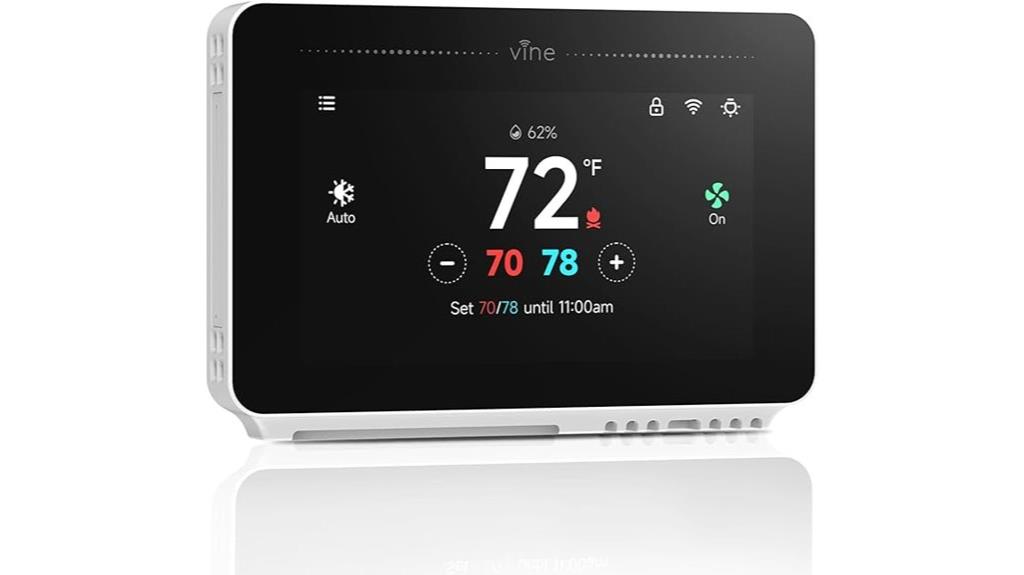
The Vine Programmable Thermostat with Touch Screen and Voice Control stands out for its easy-to-use 4.3-inch color touchscreen that automatically adjusts brightness based on room lighting, making it ideal for those who want a sleek, modern control panel. It supports app, touch, and voice controls compatible with Alexa, Google Assistant, and Apple HomeKit. With 7-day programmable schedules, Auto Home/Away modes, and features like weather forecasting, fan control, and sleep mode, it offers both convenience and energy savings. Its modern, wall-mounted design includes a backlit LCD display, making temperature adjustments simple and intuitive for daily use.
Best For: homeowners seeking a modern, easy-to-use smart thermostat with customizable scheduling and voice control compatibility.
Pros:
- Intuitive 4.3-inch high-resolution color touchscreen with automatic brightness adjustment
- Supports multiple voice assistants including Alexa, Google Assistant, and Apple HomeKit
- Offers 7-day programmable schedules with Auto Home/Away modes for energy efficiency
Cons:
- Some users report temperature readings can be inaccurate by 3-4°F
- Wi-Fi connectivity issues and limited control over display brightness in app settings
- Relies on cloud connection, which may affect functionality during internet outages
Non-Programmable Digital Thermostat for Home
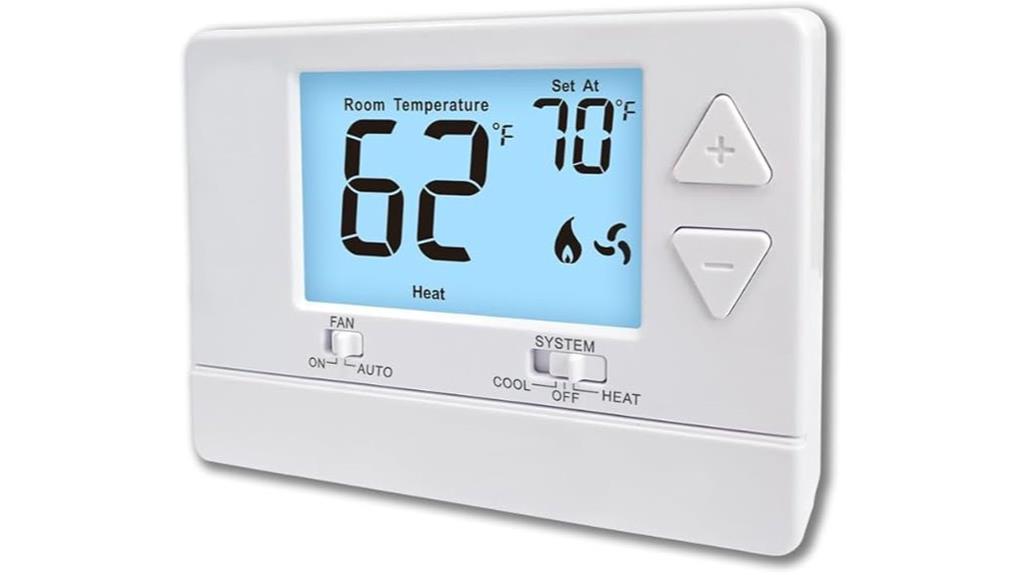
For homeowners seeking a straightforward and budget-friendly way to manage their heating and cooling, a non-programmable digital thermostat offers simplicity and reliable performance. It’s easy to install, with a large backlit LCD display and push button controls that make adjusting your temperature simple. Designed for single-stage systems like furnaces or air conditioners, it operates on 24VAC power with battery backup, eliminating the need for a common wire. Customers praise its accuracy, ease of use, and clear display. While it doesn’t offer programming features, it’s an excellent choice for those who want reliable, hassle-free control without complexity or extra costs.
Best For: homeowners seeking an easy-to-install, cost-effective digital thermostat for single-stage heating and cooling systems without the need for programming features.
Pros:
- Easy DIY installation with clear wiring instructions and minimal wiring requirements
- Large, backlit LCD display for easy visibility and simple operation
- Accurate temperature control and reliable performance suitable for basic home heating and cooling needs
Cons:
- Not compatible with multi-stage systems, heat pumps, or electric baseboard/radiant ceiling systems
- Lacks programming features for scheduling or automation
- Limited to 2-5 wire connections, so incompatible with systems requiring more wiring
Google Nest Learning Thermostat, 3rd Gen (2015)
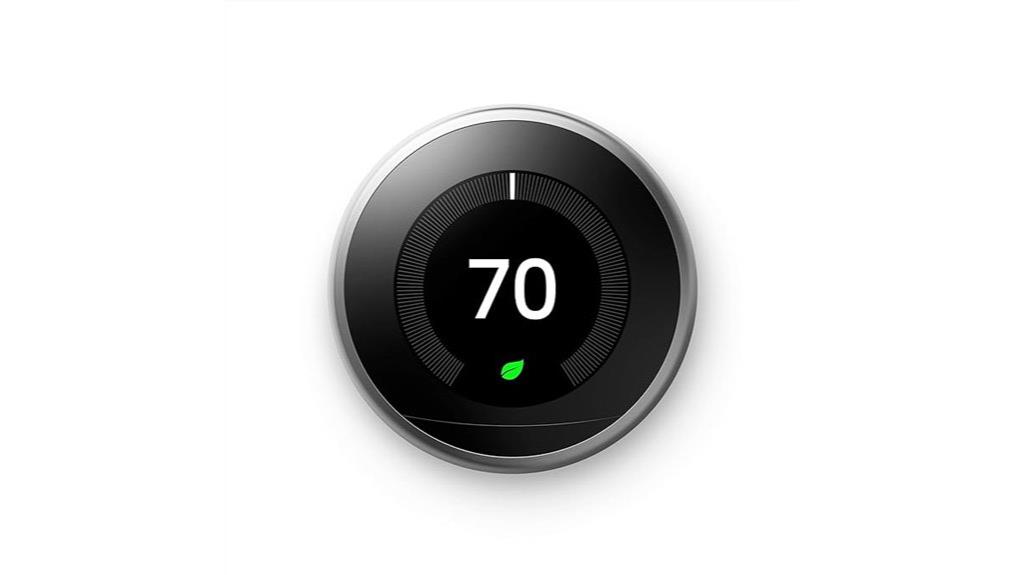
If you’re looking for a smart thermostat that automatically adapts to your habits, the Google Nest Learning Thermostat 3rd Gen (2015) is an excellent choice. It learns your schedule and preferences, programming itself to optimize comfort and energy savings. With Home/Away Assist, it detects occupancy and adjusts temperatures when you’re out, reducing waste. You can control it remotely via the Nest app from anywhere. It also provides energy history insights and encourages efficient choices through the Nest Leaf indicator. Its sleek stainless steel finish makes it stylish, and it’s compatible with Alexa, making integration into your smart home seamless.
Best For: homeowners seeking a sleek, energy-efficient smart thermostat that learns their habits and integrates seamlessly with voice assistants like Alexa.
Pros:
- Learns user schedule and preferences to automate comfort and energy savings
- Remote control via the Nest app allows convenient management from anywhere
- Home/Away Assist feature detects occupancy to reduce energy waste when unoccupied
Cons:
- Compatibility with certain HVAC systems may require additional installation steps
- Requires Wi-Fi connection for remote features and updates
- Limited to the 3rd Gen model, which may lack newer features found in later versions
Google Nest Thermostat, Programmable Wi-Fi Smart Thermostat

Looking for a smart thermostat that seamlessly learns your schedule and saves energy without constant input? The Google Nest Thermostat is a sleek, Wi-Fi-enabled device designed for easy installation and intuitive control. It features a 2-inch LCD display, supports voice commands via Google Assistant and Alexa, and connects through Wi-Fi and Bluetooth. It’s mainly compatible with heat pump systems and most 24V setups, with optional wiring enhancements. You can control it remotely using the Google Home app, which also tracks energy usage and creates schedules. Users praise its simple setup, energy savings, and smart features, though some face compatibility and wiring challenges.
Best For: homeowners seeking an easy-to-install, energy-efficient smart thermostat that integrates seamlessly with voice assistants and remote control capabilities.
Pros:
- User-friendly setup with intuitive app guidance and quick installation.
- Supports voice control via Google Assistant and Alexa for hands-free operation.
- Learns user preferences over time to optimize energy savings and reduce utility bills.
Cons:
- Compatibility issues with certain HVAC systems, especially multi-stage or specialized setups.
- Wiring challenges may require additional accessories or professional assistance.
- Limited to Google Home app ecosystem; not compatible with the Nest app or other smart home platforms.
Google Nest Learning Thermostat (4th Gen, 2024) with Nest Temperature Sensor

The Google Nest Learning Thermostat (4th Gen, 2024) with Nest Temperature Sensor stands out for its advanced temperature management capabilities, making it an ideal choice for homeowners seeking both comfort and energy efficiency. It features a larger display with Dynamic Farsight, allowing you to see information from across the room, and adjusts brightness automatically for easy readability. Compatible with most 24V systems, it’s easy to install without a C wire in many cases. You can control it remotely via the Google Home app or voice commands with Alexa, Siri, or Google Assistant. The system also supports multiple sensors, helping you optimize comfort in different rooms while saving energy.
Best For: homeowners seeking an intelligent, energy-efficient thermostat with customizable features and seamless smart home integration.
Pros:
- Features a larger display with Dynamic Farsight for easy visibility from across the room.
- Compatible with most 24V systems and typically requires no C wire for installation.
- Supports remote control via the Google Home app and works with Alexa, Siri, and Google Assistant.
Cons:
- May require a stable Wi-Fi connection for optimal smart features.
- Some users might find the setup process complex if unfamiliar with smart thermostats.
- Advanced features and integrations could be overwhelming for users seeking basic thermostat functions.
ecobee Smart Thermostat Essential, Wi-Fi Thermostat with Voice Assistant Compatibility
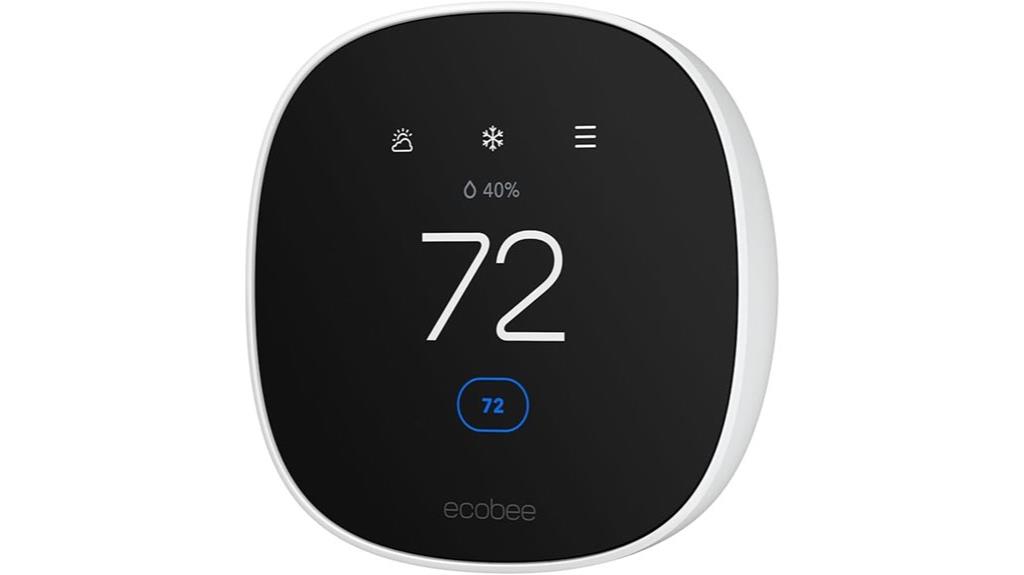
The ecobee Smart Thermostat Essential stands out for its impressive energy savings and user-friendly scheduling features. It can save up to 23% annually on heating and cooling costs by automatically adjusting to your schedule, reducing energy use when you’re away, and boosting comfort when you’re home. Compatible with most HVAC systems, including gas, electric, and heat pumps, installation is straightforward—even without a C-wire—thanks to the ecobee Power Extender Kit. You can easily control it via a colorful touchscreen or remotely through the ecobee app. It also integrates seamlessly with Apple, Google, and Amazon smart home platforms, plus voice assistant support.
Best For: homeowners seeking an energy-efficient, easy-to-install smart thermostat compatible with multiple HVAC systems and popular smart home platforms.
Pros:
- Saves up to 23% annually on heating and cooling costs through intelligent scheduling and energy management.
- Compatible with a wide range of HVAC systems, including gas, electric, and heat pumps, with easy DIY installation using the ecobee Power Extender Kit.
- Seamless integration with Apple HomeKit, Google Assistant, and Amazon Alexa, enabling voice control and automation.
Cons:
- Requires checking online for specific HVAC compatibility, which may be time-consuming for some users.
- Does not include the Power Extender Kit or trim kit in the base package, potentially increasing total cost.
- The color touchscreen, while user-friendly, may be less functional in bright lighting conditions or for users with visual impairments.
Google Nest Learning Thermostat, 3rd Gen
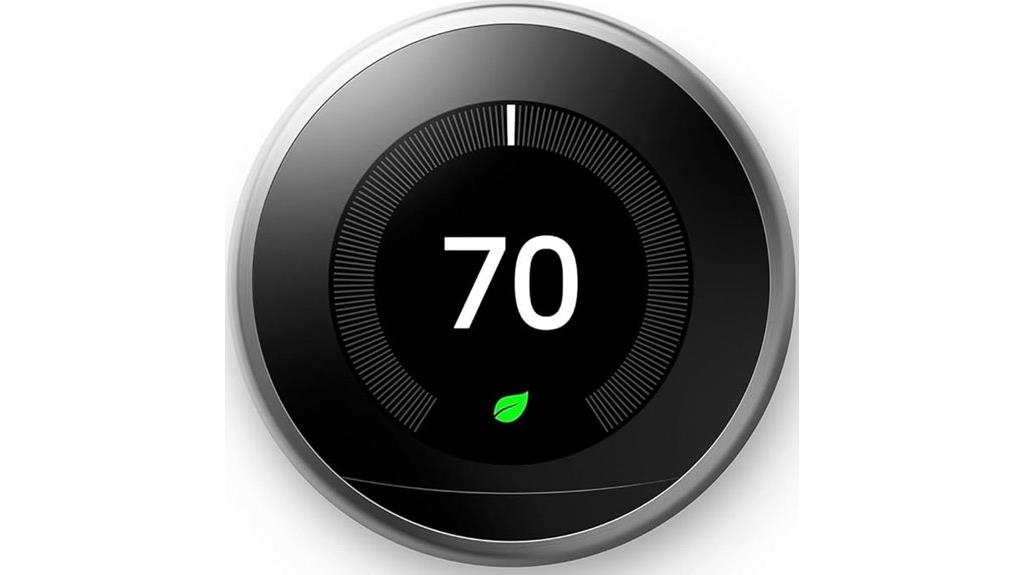
If you want a smart thermostat that adapts seamlessly to your schedule, the Google Nest Learning Thermostat (3rd Gen) is an excellent choice. It learns your routines and preferred temperatures, automatically adjusting to maximize comfort and save energy. Features like Home/Away Assist switch to Eco Mode when you’re gone, reducing waste, while Energy History helps you track consumption. You can control it remotely from your phone or tablet, and the Quick View display gives instant access to settings and energy data. It also monitors your HVAC system, alerting you to issues and providing maintenance reminders for *ideal* performance. Compatibility with Nest Sensors and Alexa makes it even more *beneficial*.
Best For: those seeking a smart thermostat that learns their schedule, enhances energy efficiency, and integrates seamlessly with other smart home devices.
Pros:
- Learns user routines and preferences to automatically optimize comfort and energy savings
- Remote control via phone, tablet, or laptop for convenience from anywhere
- Monitors HVAC system health, providing alerts and maintenance reminders
Cons:
- Requires compatible HVAC systems and possibly additional sensors for full functionality
- Higher upfront cost compared to basic thermostats
- Dependence on Wi-Fi connection for remote access and smart features
Amazon Smart Thermostat
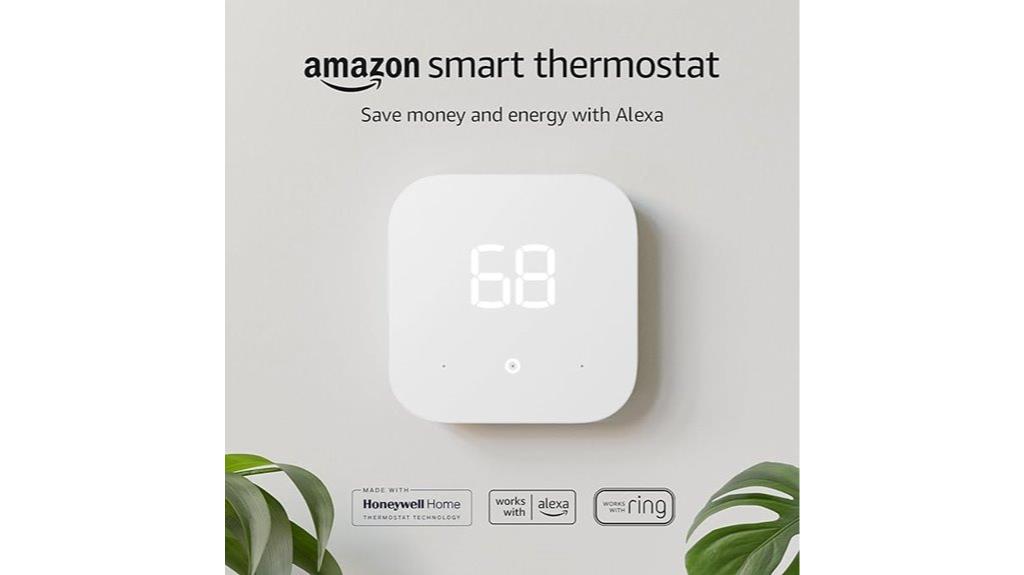
For homeowners seeking an affordable, easy-to-install smart thermostat that integrates seamlessly with Alexa, the Amazon Smart Thermostat is an excellent choice. Released in 2021, it supports most 24V HVAC systems, including force air, heat pumps, and radiant boilers, though it’s incompatible with 110-240V systems like electric baseboard heat. Made with Honeywell technology, it’s ENERGY STAR and ECOLOGO Silver certified, ensuring energy efficiency. The device offers on-device controls, app-based management via Alexa and Ring, and can learn routines to optimize comfort. Installation is straightforward with guided setup, though some users may need a power adapter or transformer if no C-wire is available.
Best For: homeowners seeking an affordable, easy-to-install smart thermostat that integrates seamlessly with Alexa and supports most 24V HVAC systems.
Pros:
- Supports a wide range of 24V HVAC systems including heat pumps and radiant boilers
- ENERGY STAR and ECOLOGO Silver certified for energy efficiency and cost savings
- User-friendly setup with app-based control and on-device touch buttons
Cons:
- Incompatible with 110-240V systems such as electric baseboard heat
- May require additional accessories like C-wire or power adapter if not present
- Some users experience initial setup issues or delayed responses with certain HVAC systems
Sensi Smart Thermostat, Wi-Fi & App Compatible
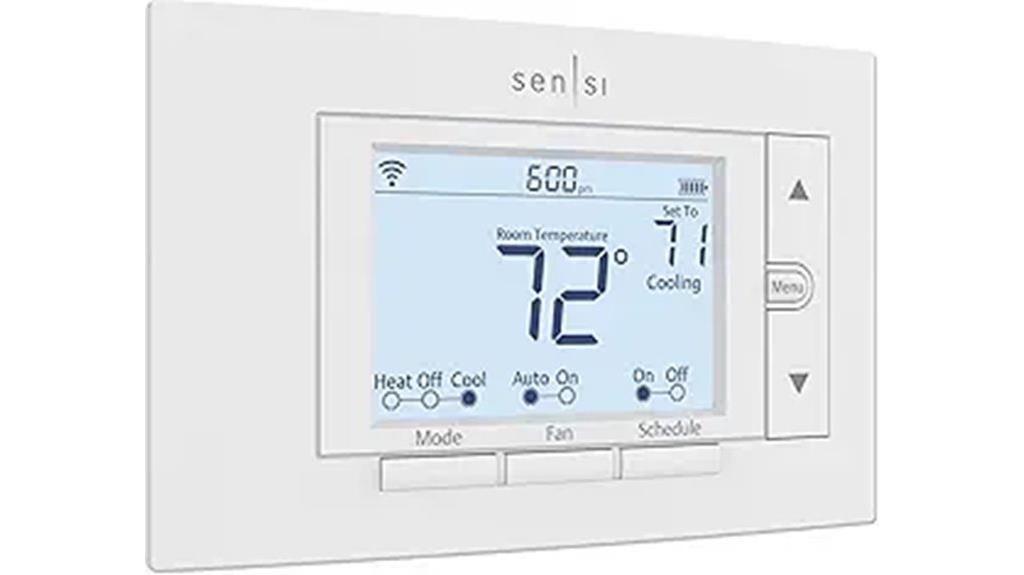
Anyone seeking a user-friendly smart thermostat that seamlessly integrates with their home Wi-Fi will appreciate the Sensi Smart Thermostat. Its straightforward DIY installation, compatibility with most HVAC systems, and support for voice control via Alexa, Google Assistant, SmartThings, and Vera make it a versatile choice. The sleek design features a 5-inch LED display and backlight, and setup is simplified with helpful app guidance. With energy-saving features, usage reports, and maintenance alerts, it promotes efficient HVAC management. Reliable and easy to use, the Sensi thermostat offers a solid balance of functionality and convenience, making it a popular pick among homeowners.
Best For: homeowners seeking an easy-to-install, energy-efficient smart thermostat that integrates seamlessly with Wi-Fi and voice assistants for convenient climate control.
Pros:
- Easy DIY installation with comprehensive mounting hardware and app guidance
- Compatible with most residential HVAC systems, often requiring no C-wire
- Supports voice control via Alexa, Google Assistant, SmartThings, and Vera, plus energy-saving features and usage reports
Cons:
- Limited integration with certain voice assistants like Bixby
- Less detailed usage reports compared to some higher-end models
- Occasional delays in setting adjustments or app responsiveness
ecobee Smart Thermostat Premium with Smart Sensor and Air Quality Monitor
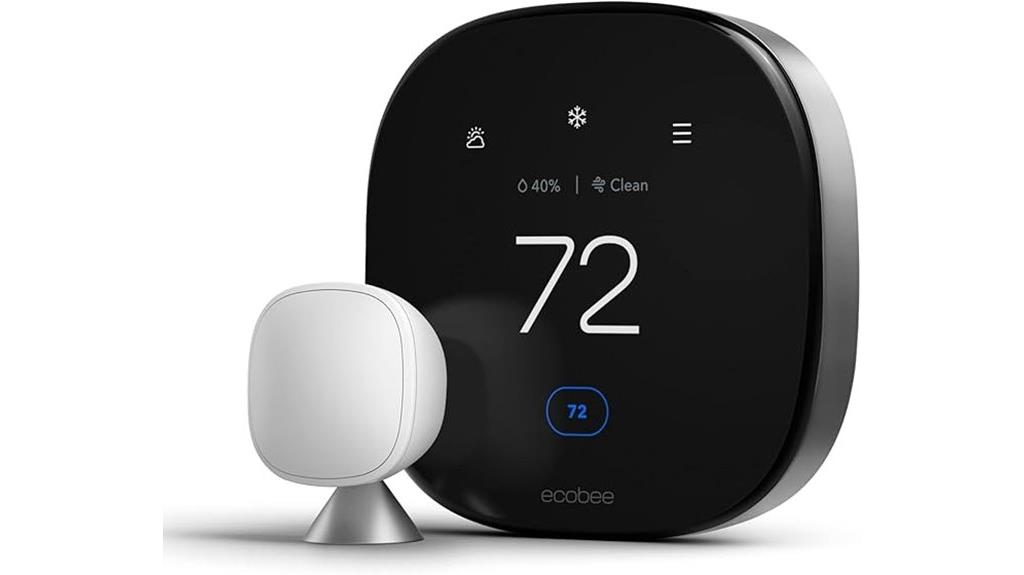
The ecobee Smart Thermostat Premium stands out for its advanced SmartSensor technology, which optimizes comfort by adjusting temperatures in key rooms and eliminating hot or cold spots. It also features a built-in air quality monitor that alerts me to poor air conditions and reminds me to change filters, ensuring healthier indoor air. With energy savings of up to 26% annually and support for multiple smart home platforms like Siri, Alexa, and Google Assistant, it offers seamless control. The sleek, vibrant display and occupancy sensing enhance usability, while its compatibility with many HVAC systems simplifies installation—though professional help may be needed. Overall, it’s a smart, energy-efficient choice for modern homes.
Best For: homeowners seeking an energy-efficient, smart thermostat with advanced air quality monitoring and seamless integration with popular smart home platforms.
Pros:
- Offers up to 26% annual savings on heating and cooling costs, reducing energy bills.
- Features SmartSensor technology that optimizes comfort by eliminating hot and cold spots in key rooms.
- Supports multiple voice assistants and smart home ecosystems for versatile control and automation.
Cons:
- Installation may require professional help, especially for wiring and sensor placement.
- Setup can be complex for users with low vision or limited technical experience.
- Support experiences vary, with some users facing delays or unclear instructions during sensor pairing and troubleshooting.
ecobee Smart Thermostat Enhanced, WiFi Programmable Thermostat
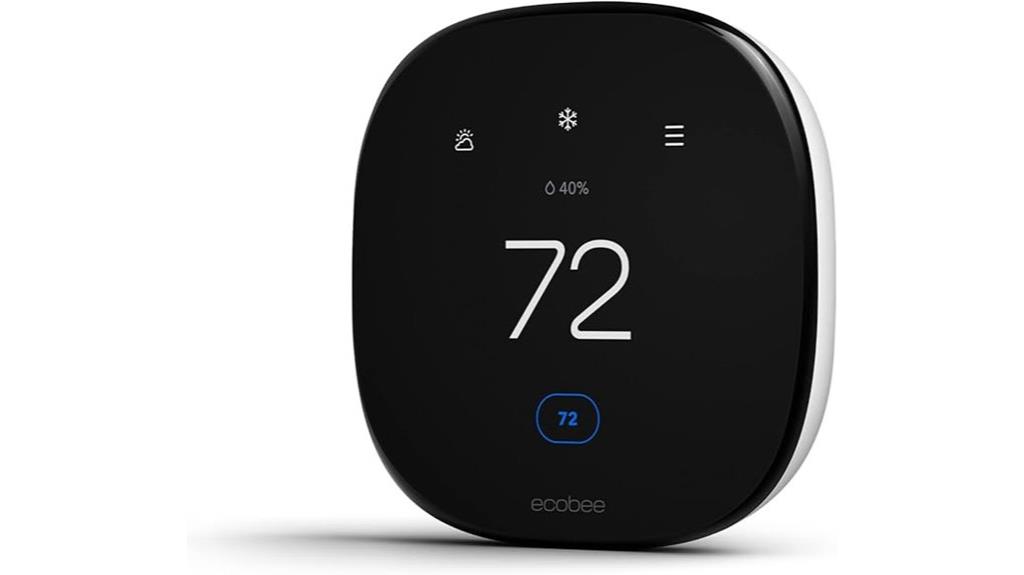
The ecobee Smart Thermostat Enhanced stands out for its advanced learning capabilities and broad compatibility, making it ideal for homeowners seeking effortless energy savings and seamless smart home integration. It can save up to 26% annually by adjusting temperatures based on occupancy, time, and humidity. Supporting most 24 VAC HVAC systems, it includes a Power Extender Kit for homes without a C-wire, simplifying installation. The sleek LCD display and app control via iOS and Android make operation easy. Compatible with platforms like Apple HomeKit, Alexa, Google Assistant, and IFTTT, it offers flexible, convenient control, all while optimizing comfort and energy efficiency.
Best For: homeowners seeking an energy-efficient, smart-compatible thermostat with easy installation and broad HVAC system support.
Pros:
- Supports most 24 VAC HVAC systems including gas, electric, oil, dual fuel, heat pumps, and boilers.
- Features intuitive touchscreen, app control, and seamless integration with popular smart home platforms.
- Offers automatic energy savings up to 26% annually through occupancy and humidity-based adjustments.
Cons:
- Some users experience reliability issues with thermostat failures after a few months.
- Customer support and technical assistance can be difficult to access or unresponsive.
- Installation may require professional help, especially for homes without a C-wire, due to wiring complexities.
Google Nest Learning Thermostat (3rd Generation, Renewed)
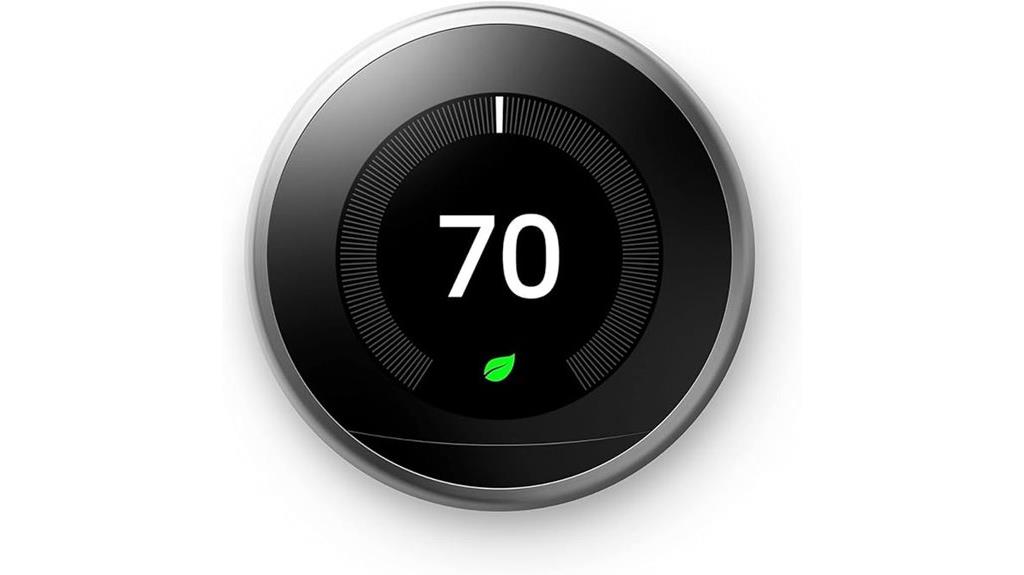
If you’re looking for a thermostat that combines sleek design with smart learning features, the Google Nest Learning Thermostat (3rd Generation, Renewed) is a solid option. It boasts a modern, stainless steel finish with a round shape and an LCD display. Compatible with Alexa and Google Assistant, it offers voice control and app access. Many users find it easy to install and effective at reducing energy bills, especially with a Duke Energy credit. However, some experience issues like Wi-Fi instability, incorrect learning habits, or complex wiring. Installation can be tricky for non-technical users, and support experiences vary. Overall, it’s a stylish, functional choice with some reliability caveats.
Best For: homeowners seeking a stylish, smart thermostat with auto-learning capabilities and compatibility with voice assistants who are comfortable with installation and potential troubleshooting.
Pros:
- Modern stainless steel design with an LCD display for easy readability
- Compatible with Alexa and Google Assistant for voice control
- Helps reduce energy bills, with available incentives like Duke Energy credit
Cons:
- Can be difficult to install, especially with complex wiring or multi-zone systems
- Reports of Wi-Fi instability and malfunctioning units impacting performance
- Support experiences vary, and costs for professional installation can be high if not purchased directly from Google
Honeywell Wi-Fi Smart Color Thermostat
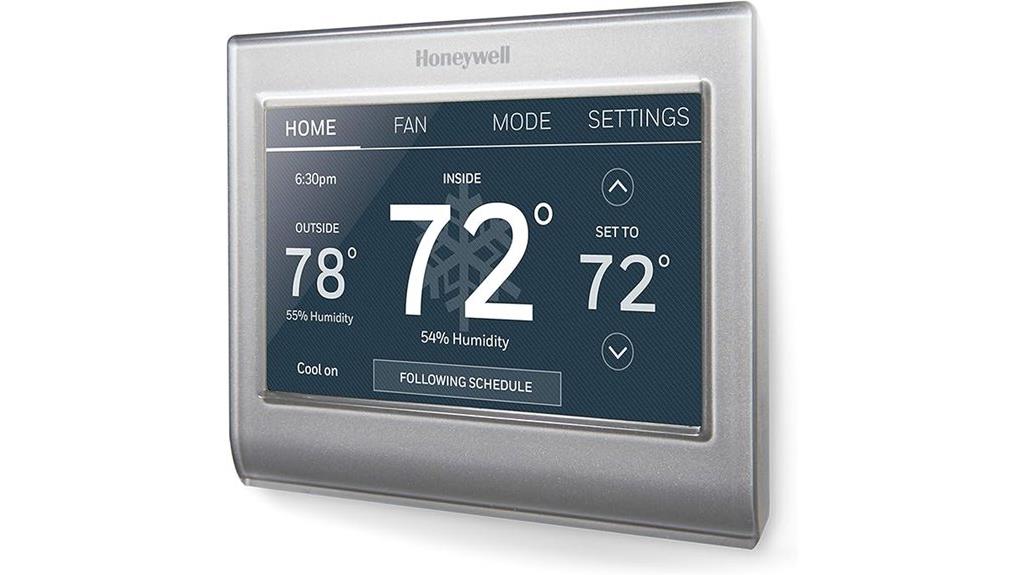
For homeowners seeking a stylish, highly customizable smart thermostat, the Honeywell Wi-Fi Smart Color Thermostat stands out with its vibrant full-color touchscreen and intuitive interface. It offers 7-day programmable scheduling, supports heating and cooling, and integrates seamlessly with Alexa, Google Home, SmartThings, and IFTTT. Its modern gray design enhances any space, while remote control via app provides convenience. The device displays local weather, humidity, and temperature, helping optimize comfort and energy use. Though setup is straightforward, handling the fragile wall plate requires care. Overall, it combines aesthetic appeal, smart features, and reliable performance, making it a solid choice for modern homes.
Best For: homeowners seeking a stylish, highly customizable smart thermostat with seamless smart home integration and remote control capabilities.
Pros:
- Vibrant full-color touchscreen and intuitive interface for easy use
- Supports 7-day programmable scheduling and energy-efficient operation
- Compatible with Alexa, Google Home, SmartThings, and IFTTT for smart home integration
Cons:
- Fragile wall plate requires careful handling during installation
- Limited remote management of advanced settings without software updates
- Inconsistent humidity readings and some touch sensitivity issues
Factors to Consider When Choosing Smart Thermostats Learning
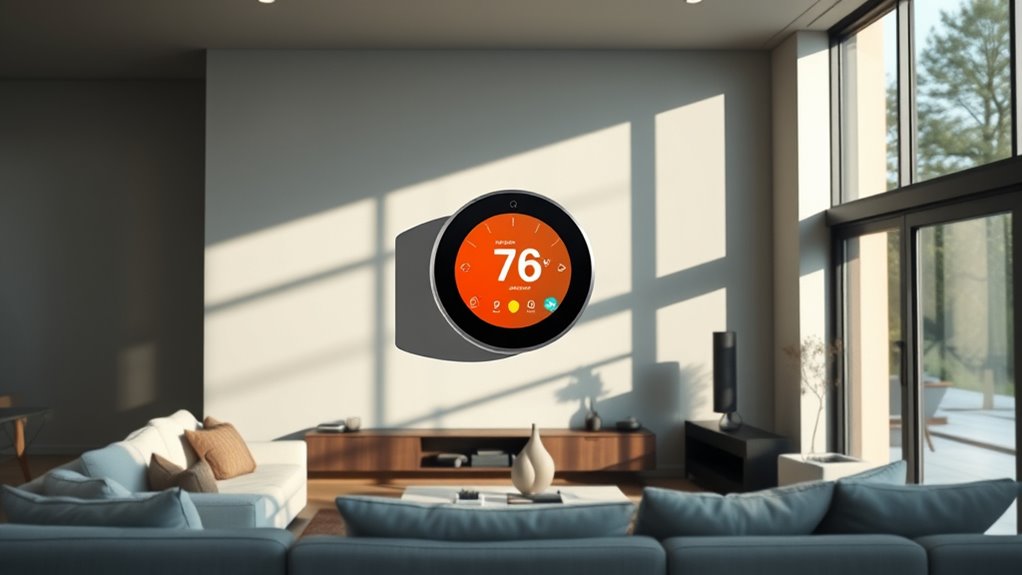
When choosing a smart thermostat with learning abilities, I consider how well it works with my existing HVAC system and the features it offers. I also look at how easy it is to install, how much energy I can save, and whether it integrates with voice control. These factors help guarantee I pick a device that fits my needs and makes managing my home more efficient.
Compatibility With HVAC Systems
Choosing a smart thermostat that works seamlessly with your HVAC system starts with ensuring compatibility. First, check that the thermostat matches your system’s voltage, stage configuration, and type, whether single-stage, multi-stage, or heat pump. Many systems also require a C-wire for power; if yours doesn’t have one, look for models with Power Extender Kits (PEK) to simplify installation. Verify that the thermostat supports your specific components, like gas furnaces, electric baseboards, radiant systems, or dual-fuel setups. It’s also important to confirm compatibility with your existing wiring diagram and control signals, such as 24V AC or proprietary protocols. Ensuring these factors match will prevent installation issues and guarantee your smart thermostat functions properly with your HVAC system.
Learning Capabilities and Features
Learning capabilities are a key feature to contemplate because they enable smart thermostats to adapt to your lifestyle and optimize comfort automatically. These devices analyze your behavior patterns over time, adjusting temperatures based on occupancy, preferred settings, and daily routines. They often use sensors and algorithms that learn from environmental factors like outdoor weather and indoor humidity, helping maintain consistent comfort levels. Some models employ machine learning techniques to fine-tune their programming, becoming more accurate and responsive as they gather data. Additionally, advanced thermostats can connect with other smart home devices, coordinating systems for better energy efficiency and overall performance. Choosing a thermostat with robust learning features ensures a more personalized, energy-saving experience without constant manual adjustments.
Installation Complexity Levels
The installation complexity of a smart thermostat depends on several factors, including your existing wiring setup, system type, and technical skills. Some models are simple to install with step-by-step app guidance, making them suitable for DIY enthusiasts. Others require more advanced wiring, such as the presence of a C-wire, or may need power extender kits, which can complicate installation. If your system supports multi-stage heating or cooling, additional sensors, or advanced wiring, expect a more intricate setup process. Manufacturers often provide helpful online guides, videos, or app-based instructions to streamline installation. Still, the difficulty can range from straightforward to challenging, depending on your home’s existing wiring and your comfort level with electrical work. Assess these factors carefully before choosing a smart thermostat.
Energy Saving Potential
Smart thermostats equipped with learning capabilities can substantially cut energy bills by automatically adjusting heating and cooling schedules based on household patterns. They typically reduce energy consumption by 12% to 26%, translating into significant cost savings over time. Features like auto-scheduling and occupancy-based adjustments help enhance heating and cooling for maximum efficiency. Integration with sensors and geofencing technology allows the thermostat to adapt to real-time occupancy and environmental changes, further conserving energy. Additionally, energy monitoring tools offer detailed usage reports, enabling me to identify habits that impact savings and fine-tune settings accordingly. However, to maximize these benefits, proper setup and calibration are essential, ensuring the learning algorithms accurately reflect my household’s energy needs and deliver ideal savings.
Voice Control Integration
When choosing a smart thermostat with voice control, it’s essential to guarantee it works seamlessly with popular voice assistants like Alexa, Google Assistant, or Siri, so I can control my home environment hands-free. I check if the thermostat’s voice features are compatible with my existing smart home ecosystem for smooth automation. It’s important that the thermostat responds accurately to commands, whether I want to adjust the temperature, change modes, or set schedules via voice. I also verify if I need extra hardware, like a smart speaker or hub, to get the best performance. Additionally, I read user reviews to ensure that voice command reliability and setup ease meet my expectations for convenience and accessibility. This way, I ensure a hassle-free, integrated voice control experience.
App Control and Access
Having reliable app control is essential when selecting a smart thermostat with learning capabilities because it allows me to manage my home’s climate remotely and effortlessly. I look for an app compatible with iOS or Android devices that offers real-time temperature adjustments, scheduling, and energy monitoring. Support for voice commands with platforms like Alexa, Google Assistant, or Siri is a big plus, enabling hands-free control. The app should have an intuitive interface, making setup easy, displaying system status clearly, and providing troubleshooting options. I also check how often the app is updated and read customer reviews to guarantee ongoing support, stability, and compatibility with new smartphone OS updates. A robust app experience ensures I stay connected and in control at all times.
Design and Display Quality
A clear, bright touchscreen display is vital because it enhances visibility in different lighting conditions and makes steering the thermostat’s features easier. A high-quality display helps me easily read settings, schedules, and energy reports without straining my eyes. The resolution and color accuracy are essential for quick recognition and clarity. An intuitive interface with responsive touch controls ensures minimal effort and faster setup. Some models let me customize themes or adjust brightness, fitting my room’s aesthetics and preferences. Additionally, durable screens prevent scratches and damage, guaranteeing long-term usability. Overall, a well-designed display improves my interaction with the thermostat, making managing my home’s climate simple, efficient, and visually satisfying. It’s a key factor when selecting a learning thermostat that’s both functional and stylish.
Support and Warranty Options
Choosing a smart thermostat with reliable support and warranty options gives me peace of mind that I’ll be taken care of if issues arise. I look for models offering at least a one-year warranty to cover defects and malfunctions. It’s vital to have access to customer support via phone, email, or live chat for quick troubleshooting and installation help. Regular software updates and security patches are essential to keep the device running smoothly and protect my data. I also check if the manufacturer provides a dedicated support portal with manuals, FAQs, and troubleshooting guides. Finally, I consider the company’s reputation for responsiveness and ease in handling warranty claims or replacements, ensuring I won’t be left stranded if problems occur down the line.
Frequently Asked Questions
How Do Smart Thermostats Improve Energy Efficiency Over Traditional Models?
Smart thermostats improve energy efficiency by learning my schedule and preferences, adjusting the temperature automatically to save energy when I’m away or asleep. They monitor my habits, optimize heating and cooling, and often allow remote control via my phone. This targeted approach reduces waste and lowers energy bills, making my home more eco-friendly and cost-effective. I love how they make managing my energy use simple and smart.
Can Smart Thermostats Be Integrated With Existing Home Automation Systems?
You’re wondering if smart thermostats can work with your current home automation system. The good news is, most are designed for easy integration, often supporting popular platforms like Alexa, Google Assistant, or Apple HomeKit. I’ve found that checking compatibility beforehand saves a lot of hassle. Once set up, I love how seamlessly my thermostat communicates with my smart devices, making home control more convenient and efficient.
What Privacy Concerns Are Associated With Smart Thermostat Data Collection?
Did you know that over 70% of smart thermostat users worry about their data privacy? When I think about the data collection involved, I realize these devices track my habits, location, and even daily routines. While they help save energy, I’m concerned about who can access that info and how it might be used. Being cautious and understanding privacy policies is key to protecting my personal data.
How Accurate Are the Temperature Sensors in Learning Thermostats?
You’re curious about how accurate the temperature sensors are in learning thermostats. From what I’ve seen, these sensors are pretty reliable, often within a degree or two of actual room temperature. They use advanced technology and multiple sensors to adjust for variations, ensuring comfort and efficiency. Of course, placement matters—putting the thermostat in a spot with consistent sunlight or drafts can affect accuracy. Overall, I trust their precision for daily use.
What Maintenance Is Required to Keep Smart Thermostats Functioning Optimally?
This question is so important I’d say it’s the backbone of keeping your smart thermostat running smoothly. To stay at peak performance, I recommend changing batteries when needed, cleaning dust from vents and sensors, and updating firmware regularly. Also, check for software glitches and recalibrate sensors if readings seem off. These simple steps guarantee your smart thermostat remains as reliable as a trusted friend, saving energy and money.
Conclusion
Choosing the right smart thermostat is like planting a seed that grows into a cozy, energy-efficient home. With the right features, you can watch your comfort and savings blossom, just like a garden in full bloom. Imagine your home adjusting seamlessly to your lifestyle, warming your days and cooling your nights effortlessly. It’s more than a gadget—it’s the heartbeat of a smarter, more comfortable living space.
